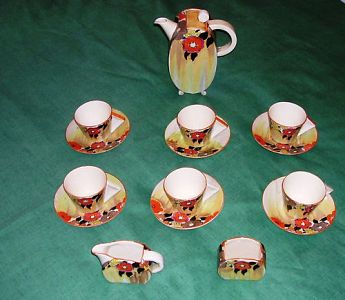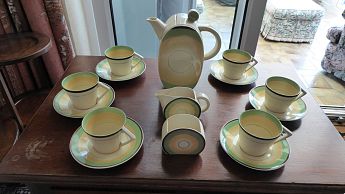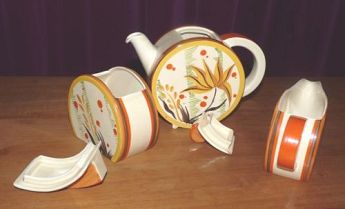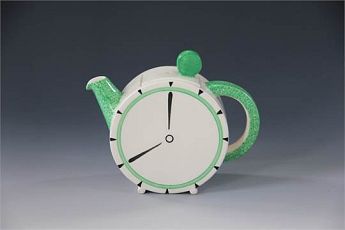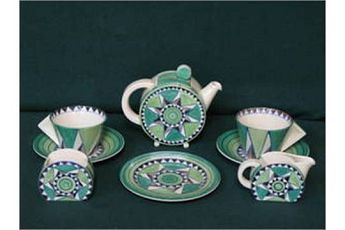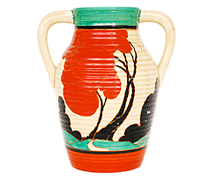Clarice Cliff Feature Articles
THE BON JOUR SHAPE 1933 - 1941
Coley Shorter was a teapot connoisseur. He actually encouraged Clarice to design and develop more teapot shapes and even played an active role in adapting her designs ensuring that they were both modern and functional. This had been never truer when Colley was highly critical of the pouring from the square-lipped spout of her Stamford teapot. Although stylistically perfect for its geometric form it poured so badly Clarice had to adapt a new version with one with a drooping (or ‘teardrop’ as some call it) shaped spout. Visually the original upward square spout looked superior in style and more balanced.
As we can see from Leonard Griffin’s “Taking Tea with Clarice Cliff” book she designed many tea sets and tableware items from 1930 onwards. There was no stopping her on the tableware front!
By 1933 the Art Deco influence in Europe had waned, but in Britain it was still growing. Certain stunning Art Deco buildings spring to mind - the Hoover Factory in west London (1932) and the De La Warr Pavilion at Bexhill-on-sea, Sussex (1936). Clarice, no doubt from her numerous magazines, was still very much influenced by European design and here in 1933 she changed the D from the Stamford (teapot) to an O for her Bon Jour (teapot) or an elongated 0 for her coffee pot.
The round, flat-sided body of the teapot was supported by small tubular feet and once again she was inspired by Tetard Freres who originally produced this shape; yet another great canvas for painting her many new patterns. The design was rounded off with a small pastille shape knopf on the lid. As a tea set, however, this was Clarice’s most mixed set as she used pieces/shapes) from the Conical, Stamford and Biarritz ranges! Furthermore, in elongating this shape for coffee pots she created a Bon Jour preserve pot, a Bon Jour vase and then turned it sideways to create the 'Tyrol' bowl. Another Bon Jour vase in the form of stepped circles with openings for flowers and water was also designed by this imaginative ceramics designer. Although sometimes criticised as a copyist, she had the most amazing talent for developing shapes for everyday use items in ceramic ware. In pottery terms she was superior in this field than any other British pottery designer - and that is what I regard as her true forte.
Bon Jour tea and coffee sets and tableware shapes generally can be found particularly in many 1933-1936 Bizarre and Fantasque patterns, e.g. Rhodanthe and its various colourways, Cowslip, Secrets, Honolulu, Idyll and Windbells. Later 1937 to 1940 ware is known in a more simple style; either in banded ware or also featuring a small floral motif.
In 1933 a size 42 Bon Jour teapot in Windbells was six shillings, and a complete Early Morning set (tea for two) in Crocus would cost fourteen shillings and three pence!
Doreen Mann
Illustrated below, left: Applique Idyll, May Blossom Pink, Honiton, and 8 o'clock.
Illustrated below, right: Lydiat, Banded, Pollen and Killarney.

